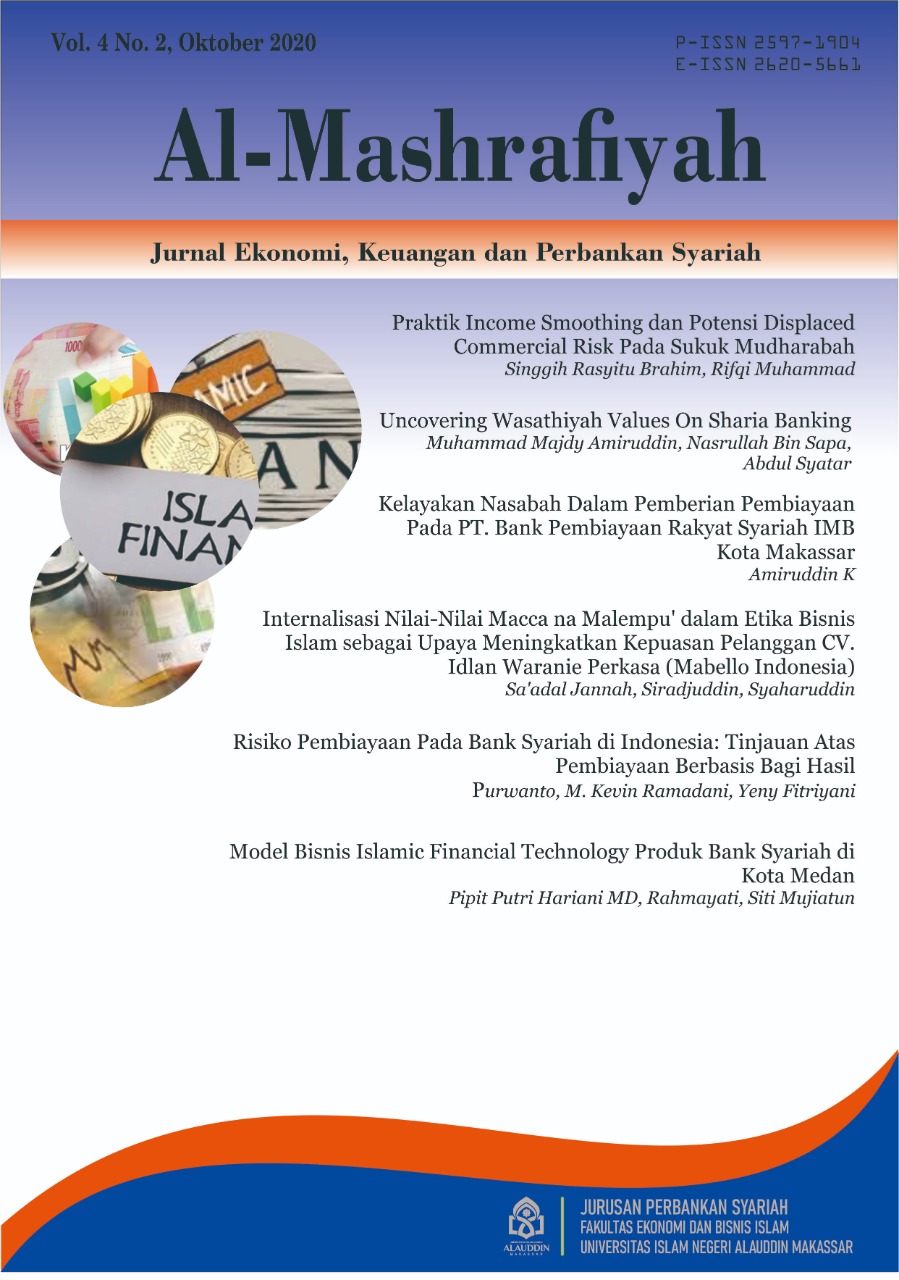Kelayakan Nasabah Dalam Pemberian Pembiayaan Pada PT. Bank Pembiayaan Rakyat Syariah IMB Kota Makassar
Abstract
The current development of banking continues to experience excellent growth, this is indicated by the increasing number of people using Islamic bank products, currently, the market share of sharia has reached 6 percent. Various of financing products of sharia bankin can meet the needs of the community. So that sharia need to analyze each financing to avoid financing risks. The purpose of this study was to determine the feasibility of customers in providing financing at PT. BPRS IMB Syariah Makassar. Then to find out the impact of customer eligibility on financing at PT. BPRS IMB Makassar city. This type of research is field research which is taken directly at the PT. BPRS IMB Makassar. The nature of the research used is qualitative. The data source of this research is primary data obtained from direct interviews with PT. IMB Makassar Islamic People's Financing Bank as well as secondary data summarized from company documents and other literature observations and documentation. The analysis technique used in this research is descriptive qualitative, by describing the feasibility of the customer in obtaining financing, as well as the impact obtained when obtaining financing at the BPRS IMB Makassar city. The results of this study indicate that in analyzing the feasibility of customer financing in providing financing, Islamic People's Bank assesses using the 5C principle, namely Character, Capacity, Capital, Collateral, and Condition of Economy and the FAST concept of Fathanah, Amanah, Shiddiq, and Tabligh. As for the feasibility impact on the provision of financing, namely for the Bank, this feasibility has a positive impact because, with the feasibility, the Bank can analyze in detail the customer's request. As for the customer, this eligibility has a negative impact because obtaining capital quickly will be hampered by this feasibility.
References
Abdullah Thamrin. 2014. Bank dan Lembaga Keuangan. Jakarta: Rajawali Pers.
Ascarya. 2013. Akad dan Produk Bank Syariah. Jakarta: PT. Raja Grapindo Persada.
Arikunto Suharsimi. 1993. Prosedur Penelitian Ilmiah: Suatu Pendekatan Praktek. Jakarta: PT. Rineka Cipta.
Ali Zinuddin. 2008. Hukum Perbankan Syariah, Jakarta: Sinar Grafika.
Budiyati. 2008. Faktor-faktor yang Mempengaruhi Pemberian Pembiayaan pada Baitul Maal wa Tamwil di Kabupaten Demak. Jurnal. Fakultas Ekonomi, Universitas Negeri Yogyakarta.
Bungain Burhan. 2012. Peneltian Kualitatif cetakan II. Jakarta: Kencana.
Darmawi Herman. 2014. Manajemen Perbankan. Jakarta: Bumi Akasara.
Fitriana Rarasati. 2007. Analisis Prosedur Pemberian Pembiayaan Mudharabah pada Bank Syariah Mandiri. Jurnal, Fakultas Ekonomi, Universitas Riau.
Husein Umar. 2005. Evaluasi Kinerja Perusahaan. Jakarta: PT. Gramedia Pustaka Utama.
Ismail. 2011. Perbankan Syariah. Jakarta: Pernada Media Group.
Ismail. 2010. Manajemen Perbankan dari Teori Menuju Aplikasi. Jakarta: Kencana Prenada Media Group.
Kasmir. 2009. Dasar-Dasar Perbankan. Jakarta.
Kasmir.2010. Manajemen Perbankan. Jakarta: Rajawali Press.
Kasmir. 2012. Analisis Laporan Keuangan. Jakarta: Rajawali Pers.
Kasmir. 2014. Bank Dan Lembaga Keuangan. Jakarta: Rajawali Pers.
Kasmir. 2015. Bank Dan Lembaga Keuangan Lainnya. Jakarta: Rajawali Pers.
Moeloeng Lexy. 2008. Metode Penelitian Ilmiah. Bandung: PT. Remaja Resdakarya.
Moeloeng Lexy J. 2008. Metodologi Penelitian Kualitatif. Bandung: Remaja Rosda Karya.
Muhamad. 2014. Manajemen Dana Bank Syariah. Jakarta: Rajawali Pers.
Natsir Moh. 2003. Metode Penelitian.Jakarta: Ghalia Indonesia.
Subagyo Ahmad. 2008. Study Kelayakan. Jakarta: PT. Elex Media Komputindo.
Surakhmad Winarno. 1998. Pengantar Penelitian Ilmiah, Dasar Metode Tekhnik. Bandung.
Soemitra Andri. 2009. Bank dan Lembaga Keuangan Syariah.Jakarta: Prenada Media Group.
Syafi’I Muhammad. 2001. Bank Syariah dari Teori ke Praktek. Jakarta: Gema Insani Press.
Yusuf Muri A. 2011. Metode Penelitian. Jakarta: Prenada Media Group.


